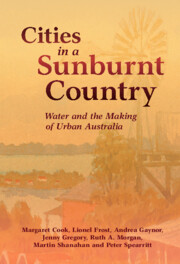Book contents
- Cities in a Sunburnt Country
- Studies in Environment and History
- Cities in a Sunburnt Country
- Copyright page
- Contents
- Figures
- Maps
- Book part
- Tables
- Acknowledgements
- 1 Prologue
- 2 Living Water
- 3 Domesticating Water
- 4 Keeping Up
- 5 Transforming Homes
- 6 Watering Suburbia
- 7 Crises of Confidence
- 8 Twenty-First Century Australian Cities
- 9 Epilogue
- References
- Index
- Studies in Environment and History
2 - Living Water
Published online by Cambridge University Press: 19 May 2022
- Cities in a Sunburnt Country
- Studies in Environment and History
- Cities in a Sunburnt Country
- Copyright page
- Contents
- Figures
- Maps
- Book part
- Tables
- Acknowledgements
- 1 Prologue
- 2 Living Water
- 3 Domesticating Water
- 4 Keeping Up
- 5 Transforming Homes
- 6 Watering Suburbia
- 7 Crises of Confidence
- 8 Twenty-First Century Australian Cities
- 9 Epilogue
- References
- Index
- Studies in Environment and History
Summary
The diverse water systems and ecologies of the places that would become Australia’s capital cities sustained Aboriginal peoples for thousands of years because of two key factors: Aboriginal knowledge of water and associated wetland and riparian ecologies, and respect for life-sustaining water as a central tenet of Aboriginal cultures. For millennia, and often enduring in the wake of the violent rupture of colonisation, Aboriginal peoples understood the affordances and risks of different forms of water and preserved these understandings in robust oral traditions. This enabled them to follow seasonal abundances of water and avoid its seasonal hazards. For all Australian Indigenous cultures, water is a storied medium that connects the past and present in the ‘long now’: a living and lively substance that sustains their Country.
- Type
- Chapter
- Information
- Cities in a Sunburnt CountryWater and the Making of Urban Australia, pp. 27 - 45Publisher: Cambridge University PressPrint publication year: 2022

